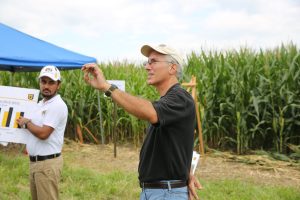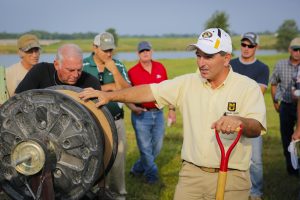This story also appears in our University of Missouri College of Agriculture, Food and Natural Resources’ Agricultural Research Center Magazine. Stop by your local Research Center to pick up a copy! You can view the magazine online by clicking here: Road to Discovery.
Nitrogen application is an incredibly important part of achieving high crop yields in Missouri and elsewhere, but management of this essential plant nutrient is challenging because it is susceptible to environmental loss. The management of that nitrogen is also incredibly important, from yield and environmental standpoints.
The Greenley Research Center is working on numerous projects related to nitrogen management, as well as agricultural lime placement, and the issues concerning that management and placement.
Nitrogen helps maintain soil fertility and its application is very important for nutritious and healthy crops. To get the best bang for their buck, farmers want to make sure that the nitrogen stays on the field, but the weather in Missouri can vary considerably within and between growing seasons, which can affect crop nitrogen use and environmental losses. Nitrogen is one of the highest input costs for farmers – but it’s difficult to know how much nitrogen to put on a field, as well as when it should be used to optimize yield and the net return on investment.
Agricultural lime increases the pH of acidic soils and can be used to reduce elements toxic to plants, such as exchangeable aluminum, in the soil. In addition, agricultural ime provides a source of calcium and magnesium for plants, again, making the crops more productive.

“Our main research effort has been on improving crop nitrogen use efficiency,” said Peter Motavalli, professor of soil fertility and plant nutrition at the University of Missouri. “Nitrogen is one of our most limiting nutrients and it’s very important in production of the principal crops in the region, especially corn. Improved nitrogen use efficiency means more nitrogen goes into the crop, increasing yields and less is lost in the environment, possibly causing contamination of air and water resources. Increased efficiency also means better economic returns for farmers.
“Ag lime is another very important soil amendment in this region for optimizing crop growth but it typically doesn’t move after it is applied to the surface soil. We were concerned that subsoil acidity was limiting crop yields and we wanted to determine if placing the ag lime deeper in the soil in no-till systems would improve crop yields.”
Motavalli has been collaborating with Kelly Nelson, a research agronomist at Greenley, on developing new nitrogen and lime management practices to provide alternatives for Missouri farmers in the claypan region. The Center, along with several other counties throughout the state, features claypan soils. Those soils are poorly drained and very challenging to manage agriculturally since they easily get saturated with water and then can dry down rapidly.
Motavalli and Nelson have done multiple experiments at Greenley over the last 18 years to develop improved nitrogen fertilizer management. They have tested a variety of ways to improve plant nitrogen use efficiency, including assessing different nitrogen fertilizer sources, different timings of application and even applying different nitrogen fertilizer sources within a single field. Their recent research has also investigated different nitrogen fertilizer placement options, including deep banding the fertilizer. With deep banding, the nitrogen fertilizer is placed about eight inches beneath the seed with or without a nitrification inhibitor product that can slow down potential environmental nitrogen loss.
“Our main thought was on what would happen if we placed the nitrogen fertilizer in different depths of the soil,” Nelson said. “Deep banding did show to be an effective practice. When it’s extremely wet, deep banding didn’t help as much, but, when it was a little drier, it did reduce gaseous nitrous oxide losses, which is one way nitrogen can be lost from the soil. Those results were consistent over a few years. The climatic conditions really make a difference on whether deep banding will be profitable or not.”
Along with deep banding, Motavalli and Nelson wondered if they could get lime deeper into the soil. Acid soil conditions in the surface soil layers can be managed by lime applications and them mixed in by tillage. Acidity further down in the soil, reducing root growth and crop productivity, isn’t as easily accessible or manageable,
especially under no-till management.

designed a tool that can inject lime at four different depths at once, the deepest of which is 20 inches.
Nelson created a way to gain a little control of deeper lime placement. He designed a tool that can inject lime at four different depths at once, the deepest of which is 20 inches.
“The goal is to affect the entire profile,” Nelson said. “Lime doesn’t move much from its placement area, so having the ability to inject lime in four different areas raises the likelihood of lime making an impact. The hope is that the plants follow the areas of injection, where there is less acidity.”
While ag lime does increase the soil pH, that process doesn’t happen overnight because the ag lime is slow to dissolve in the soil. Long-term studies are, therefore, vital
to ag lime research. Motavalli said they were able to affect pH in the subsoil with the research they did, but some alterations to the deep liming tool may be needed to make it more effective, including adjusting it to add more lime in the surface soil layers.
“This type of research is definitely a worthwhile investment to supply Missouri farmers with up-to-date and well-tested information on new liming management practices that may potentially be beneficial to improving crop productivity,” Motavalli said. “In addition, graduate students, many of whom are from Missouri, get invaluable experience and training conducting research at Greenley and they are the agricultural professionals and farmers who will have a great impact helping the farming sector in the future.”
The lime project at Greenley was funded by the Missouri Fertilizer and Ag Lime Program. That partnership, as well as having a Research Center devoted to this specific type of research, is important for researchers at Mizzou.
“Our Research Centers are very valuable,” Motavalli said. “Having those resources, each of which is addressing important issues in the regions they represent, is a great advantage for faculty and graduate students at MU. If we didn’t have these sites, we couldn’t do this type of research and students wouldn’t be as well-trained working in the field. Having Dr. Nelson, one of our premiere research agronomists, at Greenley is also a major advantage. It’s a great site that is doing important research to improve agriculture both within and outside the region of Missouri it represents.”